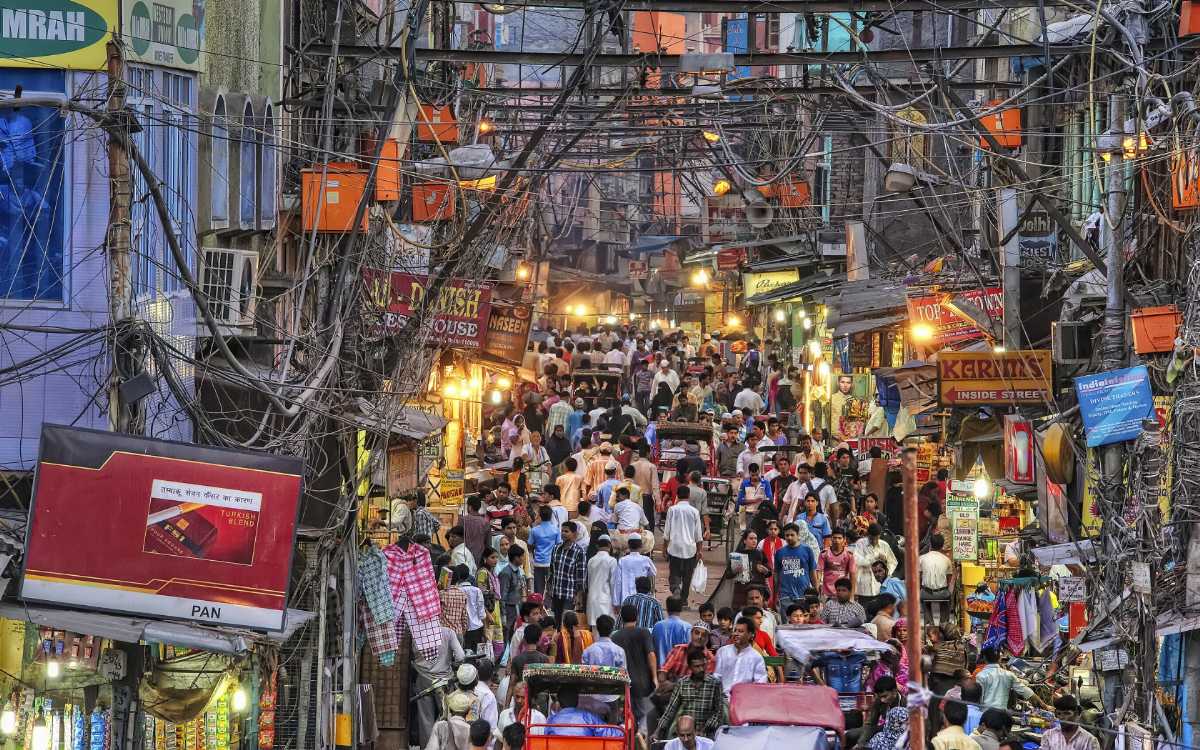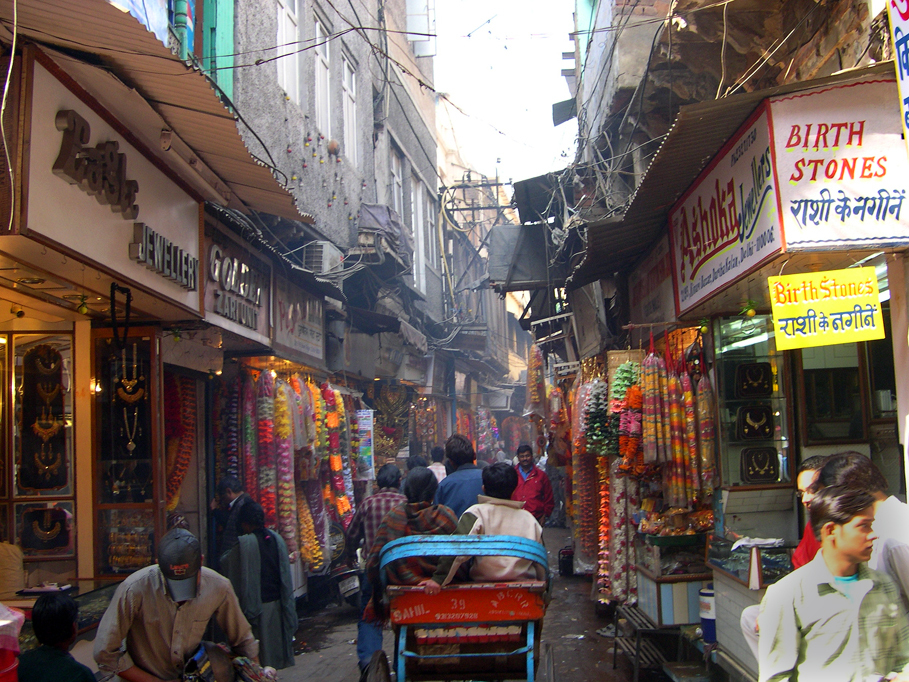The Mughal Emperor Shahjahan changed his capital from Agra to Delhi in 1648. Following this decision, construction began on some of the most popular Mughal architecture and monuments of Delhi. A major component of the new capital was its markets, which were an indispensable part of the old city. Chandni Chowk, being one of these markets, was designed by the daughter of Shah Jahan, Jahanara. The market served as the centre of not just commercial but also cultural activities back in the day, and is still one of the most popular places in Old Delhi.

HISTORY:
Chandni Chowk literally translates to “Moonlit Square” or “Moonlit marketplace”. It was built in the 1650s and was designed by the daughter of Mughal Emperor Shah Jahan, Jahanara Begum, as an addition to the newly built capital of Shahjahanabad. The bazaar was designed to resemble a half-moon shape. A water channel ran through the bazaar, originally, and it broadened to form an octagonal pool at the centre of the market. This pool of water reflected moonlight, which led to the name Chandni Chowk. The pool had a caranserai to its north and a hamman (a communal bathhouse) to its south. In the 1950s, however, this pool was replaced with a clock tower. The bazaar also had a prosperous silver trade. The word for silver in Hindi/Urdu is “Chandi“, which is possibly also connected to the name of the bazaar since the word closely resembles the word “Chandni“.


The bazaar stretched from the Fatehpuri Masjid to the Lahori Gate. It was 120 feet wide and extended over a distance of more than a kilometer. There were trees on either side of the roads to provide shade. There were as many as 1560 shops in the marketplace back then, which traded in a wide range of commodities. Items like clothes, fabric, rare jewellery, and also china, glassware were bought and sold here. Exotic perfumes could also be found in the shops of Chandni Chowk.

Jahanara Begum planned the entire area, including all the houses, mansions, streets, as well as a nexus of three markets ( the Urdu Bazaar, the Johri Bazaar, and the Fatehpuri Bazaar). The Urdu bazaar served as the residential area for soldiers as well as clerks, artisans, and artists of the Mughal court. The Johri bazaar served as a center of commerce. These three markets were also meant to offer an impressive view of the Red Fort. Despite being a place of commercial exchange, Jahanara designed the market to be artistically planned.
Despite being a market area, Chandni Chowk was also a cultural gathering place. Daily news was read out in the market, and poets would recite their poems in front of an audience to receive feedback and officers gathered for Mushairas here. Both elites and nobles would shop here. The coffee shops or kahwe khane became popular meeting spots. During the Mughal period, imperial processions also passed through Chandni Chowk. This tradition was also followed by the British.

ABOUT THE ARCHITECT: JAHANARA BEGUM
Jahanara Begum (1614-1681) is widely regarded as Emperor Shah Jahan’s favourite daughter. She commanded great influence during the reign of her father. She was granted the title of Padishah Begum (First Lady) by Shah Jahan after the death of her mother, Mumtaz Mahal. She was also bestowed with other titles like Sahibat al-Zamani (Lady of the Age) and Begum Sahib (Princess of Princesses). She was a well-educated and influential woman and took great interest in the teachings of Sufism. She also controlled a great amount of resources due to her high standing, and often used this wealth to fund architectural projects, works on Sufism, as well as other scholarly pursuits. Apart from architectural initiatives like Chandni Chowk and Sarai Begumabad, she also patronised works like commentaries on Masnavi of Sufi mystic and poet Rumi. The contributions of Jahanara to the city of Shahjahanabad are important to note since they enable us to understand the role of (royal) women in the 17th-century Mughal society.

DECLINE AND REBIRTH:
Following the death of Aurangzeb, the Mughals faced a long period of instability until their eventual decline. The city of Shahjahanabad was plundered quite a few times. Naturally, Chandni Chowk also faced destruction. During the revolt of 1857, considerable destruction was caused to the site. The Khooni Darwaza (the place where the sons of Bahadur Shah Zafar were shot during the revolt) is also situated close to Chandni Chowk. Several changes were also made by the British to the market. The canal that gave the market its name was covered, the caravanserai was replaced by Delhi town hall, and Bagh Sahibabad was torn down to accommodate the railway. The British durbars of 1877, 1903, and 1911 also caused considerable disturbances since new buildings had to be constructed. Yet, in spite of these challenges, Chandni Chowk is a bustling marketplace, almost always jam-packed with shoppers and visitors even to this day.

CHANDNI CHOWK TODAY:

Even though its original artistic appearance, envisioned by Jahanara, has evanesced, Chandni Chowk is still a very important landmark. The market has all kinds of shops imaginable. The Kinari Bazaar is famous for all things wedding-related, including vibrant clothes, sarees with zari and chikankari work, jewellery, etc. Sites like the Chunamal Haveli (mansion of a wealthy businessman, built in the 1800s) and Haveli of Begum Samru (Bhagirath Palace) can also be found in Chandni Chowk. The Bhagirath Palace is a wholesale market for electronic and related items. The Nai Sarak contains a wholesale market for books for students, and connects Chandni Chowk to Chawri Bazaar. Moti Bazaar is an ideal spot to buy exotic perfumes and scents as well as vintage jewellery. Fatehpuri Market is renowned for spices and dry fruits, and a street called Khari Boali is reserved exclusively for spices, dry fruits and nuts, pickles, grains, and lentils etc.


The Shri Digambar Jain Lal Mandi is the oldest Jain Temple in Delhi and is located in front of the Red Fort. The Jama masjid of Delhi, right across the Red Fort and Sunehri Masjid, which is one of the largest mosques in India and has been an important site since the time of the Mughals. Urdu Bazaar, located near Jama Masjid, is a marketplace for Urdu literature. It is, unfortunately, facing a decline in the current times with an increasing lack of interest from shoppers. Speaking of Urdu literature, Ballimaran is a neighbourhood with narrow lanes branching from the main Chandni Chowk street, which has the haveli of the celebrated poet Mirza Ghalib, and it is also famous for its eyes, footwear, and textiles. Dariba Kalan is a market for precious stones and silver, and gold jewellery. Gurudwara Sis Ganj Sahib (located on the street Dariba Kalan) was constructed in 1783 to commemorate the martyrdom of Shri Guru Tegh Bahadur (the 9th Sikh Guru). Bhai Mati Das Museum is located nearby and is dedicated to the history of Sikhism and Sikh martyrs. Opposite to Gurudwara Sisganj Sahib is Central Baptist Church. Established in 1814, it is one of the oldest churches in Delhi.


CONCLUSION:
Chandni Chowk is an extremely appealing place. It attracts visitors in abundance, with some reports suggesting a footfall of around four to six lakh visitors daily! It is still full of life centuries after it was built. It is also regularly referenced in popular media, with movies like Kabhi Khushi Kabhie Gham (2001), Chandni Chowk to China (2009), Delhi-6 (2009), The Sky Is Pink (2019), etc., being filmed in the locality. The history of the place is extremely fascinating, and so are its shops. Whether one is interested in buying clothes, enjoying a delicious snack, visiting a place of worship, or purchasing something from a wide range of commodities, Chandni Chowk has something for everyone.

REFERENCES:
-
Ghosh, R. (2024). IMAGING INDIA. GUIDED SELF PUBLISHING LLP.
- Liddle, S. (2017). Chandni Chowk: The Mughal City of Old Delhi. Speaking Tiger Publishing Private Limited.
- https://www.historyhit.com/locations/chandni-chowk/
- https://theuntaughthistorian.com/2025/02/07/discovering-jahanara-begum-through-chandni-chowk/#:~:text=By%20the%2019th%20century%2C%20the,market%20street%20changes%20over%20time%3ADiscovering
- https://www.sahapedia.org/chandni-chowk-jahanaras-glorious-moonlight-square-turned-dust
- https://www.sahapedia.org/women-patrons-and-the-making-of-shahjahanabad
- https://rediscoveringdelhi.travel.blog/2020/04/13/chandni-chowk/#:~:text=Then%2C%20the%20English%20government%20imposed,Town%20Hall%20in%201860%2D65CHANDNI%20CHOWK%20%E2%80%93%20Rediscovering%20Delhi.
- https://www.prathaculturalschool.com/post/jahanara
- https://www.captureatrip.com/blog/shopping-in-chandni-chowk
- https://www.tripoto.com/new-delhi/trips/secrets-of-delhi-6-that-give-you-a-perfect-dose-of-indian-history-56e69ae755e70
- https://en.wikipedia.org/wiki/Chandni_Chowk




